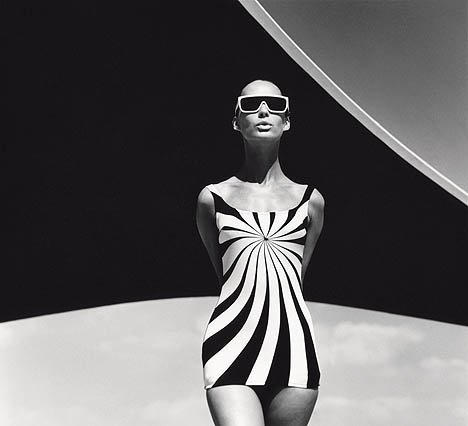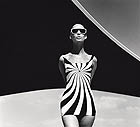
translated and summarized by: Liz Wollner-Grandville,
English summaries December 13 - January 15
Kunsthalle Wien
Vanity - Fashion/Photography from the F.C. Gundlach collection
21.10.11 to 01.04.12
No Vanity, please!
Is it the fashion now in photography that art takes the benefit, or much more, that it's that fashion that tends towards art? For F.C. Gundlach, erstwhile fashion photographer, gallery owner and above all, lobbyist in things pertaining to photography, the question – whether free or applied – is the same, "there is no commercial picture or non-commercial picture; there's only a good or a bad picture".
And then there are exhibitions that have been going around for years in different constellations presenting a collection, and those where one isn't quite sure whether the choice of position can compete with the definite relevance of the theory. In a good compilation, one can have both phenomena at the same time – something that is presently possible in the Kunsthalle in Vienna.
Gundlach himself, whose collection of fashion photography under the title, "Vanity", stretches from the late 20's to the present with shots from "Germany's next top model", approached the then-current art in the second half of the "sixties", quite decidedly with his own works. In black and white shots, the structure of the pictures was strictly geometric - the lovely Grace Coddington - today creative head of the American Vogue - poses on the coloured variation in front of colourful Roy Lichtenstein similar backgrounds as the saucy Uptown Girl. The collection of fashion photography is select, ranging from the classics such as Richard Avedon or Regina Relang to Erwin Blumenfeld, Wols or Horst P. Horst, Leon Levinstein, David Lachapelle and Melvin Sokolsky, who in the first half of the 60's let his models float around in huge bubbles through urban scenarios.
However, Peter Weiermair's curated show "No Fashion, Please! Photography between Gender and Lifestyle", devotes itself to the view in the other direction in which artists take over the strategies of fashion photography and orchestrate bodies and their clothing. That may function wonderfully in positions by Fergus Greer, Matthias Herrmann, Izima Kaoru or Alex Prager. By some others, such as Tracy Baran, Bruce Weber or Brigitte Niedermaier it possibly plainly means something completely different – dressed or not.
In the end, fashion is what one interprets it as: what one makes of it, even if it's only its temporary appearances. About vanity, in correlation with the Kunsthalle, you can read often enough.
By Daniela Gregori
The exhibition
No fashion, please!
Photography between Gender and Lifestyle
runs until 29 January 2012
Kunsthalle Wien
1070 Vienna, Museumsplatz 1
Tel: +43(0)/ 1/ 521 89-0
Fax: +43(0)/ 1/ 521 89-0
www.kunsthallewien.at
Opening hours: daily from 10-19 hours
Künstlerhaus Wien
Contemporary Witnesses – Photography in Austria since 1945
15.12.11 to 29.01.12
Obscure Second Republic
The Viennese culture scene, Leopold Figl on the balcony of the Belvedere, Ostbahn-Kurti at a concert, Gsellmann's world machine, young prostitutes in the Stuwer Quarter, a rubbernecker in a brothel, the Beatles making a film, the actionists, the painter Attersee and so on, and so on: the exhibition in the Künstlerhaus ("Contemporary Witnesses - Photography in Austria since 1945"), organized and designed by the Society for Photography, encompasses an enormously wide spectrum of political and social realities in the Second Republic. But one didn’t let it rest there: one doesn't just include documentaries but also all the other available genres of photography as well.
For the catalogue, there was the amusing idea of quite simply putting the photos in strict order of their year of origin – amongst them photos by Inge Morath, Ernst Haas, Erich Lessing or Barbara Pflaum, as well as by fine arts academicians (Christa Biedermann, Valie Export, Arnulf Rainer, Franz West, Erwin Wurm), fashion photographers (Elfie Semotan) or press photographers whose names were not so well known outside their field (Helmut Fohringer, Hans Klaus Techt, Heinz Stephan Tesarek).
By contrast, the exhibition, which was advertised as "fully unconventionally conceptualized”, pursues absolutely no order – and that's not exactly an advantage. Admittedly, the different heights at which the pictures are hung have proven to be a great success; but it remains completely obscure as to under which criteria the show has generally been compiled. Certainly some discoveries are worth it, such as Jork Weismann's sleeping Patti Smith, Lukas Beck's skipping boys' choir, Alfred Seiland's pale washing in winter scenery. Likewise, some combinations focus on exciting structured parallels (such as a plant by Elfriede Mejchar next to a diver by Lothar Rübelt, whose inglorious role in National Socialism has been faded out in the catalogue) and can't pick up the general randomness of the picture hangings. Perhaps the organizers should have sought professional curator support.
By Nina Schedlmayer
Künstlerhaus Wien
1010 Vienna, Karlsplatz 5
Tel: 01/587 96 63
www.k-haus.at
Opening times: daily from 10-18 hours
MAK Applied Arts/Contemporary Art
Envisioning Buildings – Reflecting Architecture in Contemporary Art Photography
07.12.11 to 22.04.12
First Aid packet – without instruction leaflet
One doesn't really notice that the exhibition "Envisioning Buildings – Reflecting Architecture in Contemporary Art Photography" in the MAK has only very hastily been put on the program by the new director, Christoph Thun-Hohenstein. Because designer Helmut Lang unexpectedly cancelled his Personale, a “first aid packet” had to be found quickly for the large hall. That Thun-Hohenstein decided upon architecture photography shows programmatically that he's going in the right direction.
Curator Simon Rees presents the genres under eight different aspects. Although the starting point - Thomas Ruff's photography of Mies van der Rohes' Villa Tugendhat – may be irritating. Also the "glass electronic film music” by Liam Gillick, which appears, above all, esoteric and which accompanies Sarah Morris' Modernism study, may not make a very strong first impression. But the exhibition is equally removed from heroization as glorification - and lays more emphasis on analysis and critic.
This is shown in the first room in which the works by Andreas Fogarasi and Allan Sekula subtly light up the instrumentalisation of architecture; or the series by John Massey in which a glass luxury domicile appears to make the art within it, as well as the outside world, frighteningly sterile. Also the 50-piece work by José Davila ("Buildings you have to see before you die") takes on a critical approach: iconic architectural photographs are replaced by white spaces – the resulting areas throw up the question of what meaning can be attributed to the signal effect of architectural blueprints. In addition to this, the exhibition creates elegant passages between the individual chapters, for example, where different shots of the Schindler house in L.A. (Candida Höfer, Hiroshi Sugimoto) refer to diverse aspects.
Occasionally one would have liked other works instead of, for example, the short video sequences by Cyprien Gaillard, which only show modernistic buildings in the background; a "Desniansky Raion" (and many other works) would have fitted the utopian theme better. One asks oneself why the most important domestic position in present day architecture photography, namely Margherita Spiluttini, has been forgotten. A real shortcoming is apparent in the almost non-existent basic information: visitors who are not architecture experts have to find many of the pictured buildings by trial and error from the information given on the audio guides, if the information is there at all. The instruction leaflet is missing from the first aid packet – which was, however, altogether appealing.
By Nina Schedlmayer
MAK-Applied Arts/Contemporary Art
1010 Vienna, Stubenring 5
Tel: +43(1) 711 36-0
Fax: +43(1) 711 36-227
www.mak.at
Opening hours: Tue (MAK Nite) 10.00-24.00 hours, Wed-Sun 10.00-18.00 hours
Kunsthaus Bregenz
Valie Export - Archive
29.10.11 to 22.01.12
Much more than a 68 "Shocker"
By focusing on VALIE EXPORT's archives, the Kunsthaus Bregenz has succeeded in throwing a light on her work which has enabled nothing less than a new, encyclopaedic discovery of the artist. However, it still remains to be proven that her latest works are of the same relevance as her earlier ones, the latter which, in the meantime, have become icons of art history.
Altogether, 800 objects from the archives, displayed in cabinets mounted on wooden blocks, can be studied on the first floor of the building. Lesser known works from the area of conceptual photography are to be found here, as well as the precursors to those three actions which have been burned into the collective memory: the documents for the "tap-and-touch cinema" and also pictures of those jeans, cut open at the crotch in which the artist displays her pubic hair whilst carrying a machine gun in her hand. While there is much historical material on the first floor that is partially being displayed in public for the first time, the well-known "end products" can be viewed on the second floor.
The real tap-and-touch cinema is on the second floor in a replica authorized by the artist. In the "film forest" on the third floor, 30 VALIE EXPORT films can be viewed simultaneously as an elaborate artistic synthesis. Here, every possible film projection technique since the 60's can be found, from "Super 8" to "16 mm" and from DVD to monitors.
This exhibition in the Kunsthaus Bregenz offers the possibility to scrutinise the deeply fixed prejudices about forty years of VALIE EXPORT's creations. There's the Avant-garde-like filmmaker, a conceptual photographer and a meticulous collector of highly interesting contemporary documents to be discovered who is much more than a shocker of the milieu Catholicism of the 60's. The painfully precise view of the feminist artist shows the mechanisms of power and powerlessness of society, which every now and then transforms into open sadomasochistic situations through sentimentality and hate.
VALIE EXPORT sees the revolutions of the 60's being brought back to life in the "Occupy Wall Street" movement. Admittedly, her latest works illuminate the epoch-making actions of the 60's but they are probably not as meaningful. Export did not have an untypical Austrian fate: she was only acclaimed in Austria after her exhibitions in the Lentos Museum and the Belvedere and now through the exhibition in the Kunsthaus Bregenz, but over the decades, she has been a veritable larger-than-life art export overseas. As a matter of course her works are represented in important collections such as the Tate Modern in London, the Centre Pompidou in Paris or in Moca in Los Angeles. Austria simply didn't bother.
By Wolfgang Ölz
Kunsthaus Bregenz
6900 Bregenz, Karl Tizian Platz
Tel: +43 5574 48 594-0
Fax: +43 5574 48 594-8
E-mail: kub@kunsthaus-bregenz.at
www.kunsthaus-bregenz.at
Opening hours: Tue-Sun 10-18, Thu 10-21 hours
Mehr Texte von translated and summarized by: Liz Wollner-Grandville


 Teilen
Teilen



